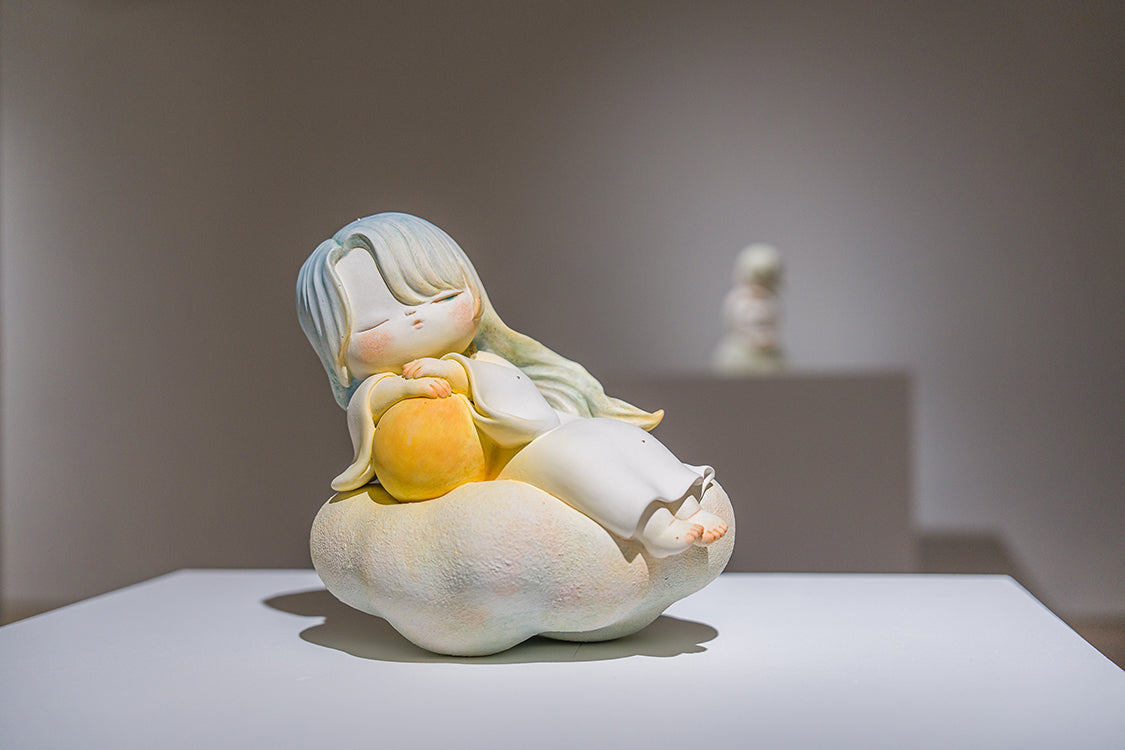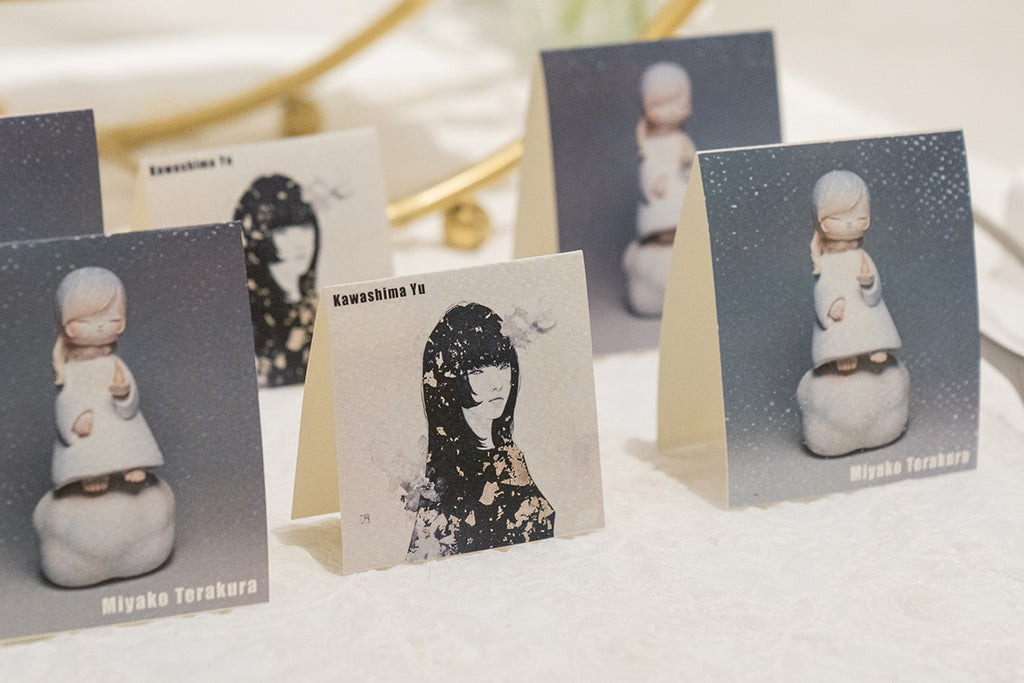ARTICLES
Crafting a Soft and Warm World Through Hand-Building: Interview with Miyako Terakura
2025.06.10
INTERVIEW

Works made of soft-looking white clay have a texture that makes you want to touch them. The expressions of children floating on clouds make you want to gaze back at them, precisely because you can't tell what they're thinking.
Miyako Terakura has consistently created warm, embracing works with children as her motif. Through the existence of "children" as symbols of innocence, her works reflect our own lives. We spoke with Terakura about the thoughts underlying her creative process, the mystery of her headpiece designs, and the concept behind her current exhibition.
The Form of Innocent Children Reflects

Whitestone Ginza New Gallery
- Why have you continued to create works with children as a motif for so many years?
Terakura: Because children can be considered symbols of innocence and beings in whom we can place our hopes. I believe there's meaning for me in creating works using such children as motifs in pottery, a material that lasts for a long time.
Children are interesting and mysterious, aren't they? Many people find them cute or special... I think children are beings with whom everyone can connect emotionally. Also, since everyone has a childhood in their growth process, I see them as beings onto whom we can project our former selves. If it's a child, we can view them as a familiar friend-like presence.

Whitestone Ginza New Gallery
While I do put my own thoughts and messages in my works , I’ve always thought of children as beings that have a natural ability to connect with people’s emotions. That’s why they’ve continue to be a central motif in my work.
I'm also attracted to the cute, soft, pudginess of children which I want to express. I also intentionally avoid giving them distinct facial expressions. There are subtle variations, but I want them to be presences that align with the feelings of the viewers at that moment.
A Presence That Receives and Watches Over

Whitestone Ginza New Gallery
- What kind of prayers or messages do you want to express in this exhibition? What are these prayers directed toward?
Terakura: I think of prayers as "wishes for the future." Rather than consciously praying strongly for something specific, it's a hope that each person's heart and daily life remains peaceful. While I do infuse my own feelings, I create them as vessels to gently embrace the thoughts and feelings of each viewer. In that sense, for this exhibition, I think the word "prayer" fits well.
- For example, would it be fair to say that your works are like vessels—open to whatever the viewer brings to them, whether it’s memories of their own child or a wish for world peace?
Terakura: Yes, that’s right. They also carry the image of guardian deities, like Jizō or other sacred figures. Since ceramics have the ability to last for generations, I hope my works can become quiet presences that watch over us across time.
Surrendering to the Flow of Clouds

Whitestone Ginza New Gallery
- Please tell us about the inspiration and concept behind the title of this exhibition, "Where the Clouds May Lead" .
Terakura: I decided on it based on an image that overlays the transience and shifts of human life, which I feel as I live day to day, with surrendering oneself to the flow of clouds. In life, we decide and proceed in the direction we want to go, but there are inevitably things we cannot resist and the flow of time. When looking at clouds, seeing how water circulates, becomes clouds, flows, and cycles, I think that perhaps our lives, and broadly speaking, life and history over a long time, exist as one part of repetition within a long span of time. That's what I was thinking about when considering this theme.
The Imagination Embodied in Rabbit Costumes

Whitestone Ginza New Gallery
- The works with animal ears. Are the children wearing costumes, or are they the animals themselves?
Terakura: I create them as children wearing animal costumes. They're anthropomorphized, becoming character-like expressions, so they might be difficult to interpret. To begin with, the children in my works don't have models; they aren't real children who exist in reality. They are children who unconsciously exist in my heart. I create them with an abstract or iconic presence, like an image of fairy-like children.
- There seem to be many rabbit costumes this time. Why is that?
Terakura: Simply because I like rabbits' existence and visual appearance with their long ears and round tails. I don't have a particularly deep relationship with real rabbits, but they've been a motif I've liked since childhood. I like dogs as animals, but for some reason, I'd draw rabbits when doodling.

Whitestone Ginza New Gallery
- There are also sheep and non-animal headpieces like apples. How do you decide on these?
Terakura: Yes, there are sheep. I created them with the image of the story of three sheep. I'm expressing a kind of character of children playing roles in school performances with these headpieces. This is also a playful piece.
As for the rabbits riding on clouds, there's the story about rabbits living on the moon, right? That legend has stayed with me since childhood, and I personally really like it, so I create from that. I'm drawn to the existence of rabbits living in the sky.
- Do you often get inspiration from fairies and things that don't exist in reality?
Terakura: Yes. I find the human imagination that thinks up such stories fascinating. I don't have many artists or works that have influenced me; I think about motifs and themes for my works from things close to me, nature, and events.
The Softness and Uniqueness of Hand-Pinching

Whitestone Ginza New Gallery
- Why do you choose to mostly show casehand-built works this time?
Terakura: When I use porcelain slip casting—where you pour liquid clay into a mold—you end up with identical shapes each time. That method has its own creative appeal, but with hand-building, you shape the clay entirely by hand, and I’ve been really enjoying that process lately. There’s a certain personal joy in making each piece from scratch. And of course, the biggest difference is that no two hand-built works are ever the same.
Even when I use molds, I usually modify the form after removing it sculpting or altering the shape to give each one a bit of individuality. I try to add small variations while the clay is still soft, to give each piece a unique character. But for this exhibition, all of the works were newly created using only the hand-building method.
- So it's the most suitable method for this particular series of works.
Terakura: Yes that’s right! Also, from a practical standpoint, hand-building also allows me to create larger works with my current physical ability. It’s a more intuitive and freeing technique. By pushing out from the inside, pressing, or hollowing the clay, I can express soft, organic qualities like the buoyancy of clouds or the gentle, rounded shapes we associate with infancy.

Whitestone Ginza New Gallery
No two works created by hand-built are the same. This parallels how each of our lives is unique. Amidst our daily lives that flow and change like clouds, Terakura's works stand quietly, accepting each viewer's memories and wishes. I hope you'll visit the venue to directly experience their soft forms and warm gaze.



